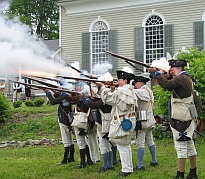
In 1755, The Rev. Samuel Seabury first traveled from Hempstead, Long Island to Dutchess County on a missionary visit sponsored by the Society for Propagation of the Gospel (SPG). There were about 13 dwellings and a church, a tavern and a schoolhouse along the main road from the break in the mountains to the south, to the west side of today’s village. Seabury reported to the SPG that there were a good number of people in the county willing to support an English church and buy a glebe if they could get the Society’s help in obtaining a clergyman and paying him.
A subscription by over 100 families was taken in 1756 to erect an English church in Fishkill, and money began to be raised. With the help of The Rev. John Beardsley, an agreement was reached with the SPG in 1766. It required a glebe (a farm, the income from which supported the priest) and £60 a year for salary from the people, and the SPG agreed to provide a library and £35 annually. Two churches were involved, Trinity in Fishkill and Christ Church in Poughkeepsie, since neither could afford a glebe or a priest individually. The glebe was purchased in Poughkeepsie. The Glebe House on Main Street in Poughkeepsie is the original house built for Beardsley, and the glebe surrounded it on the north side of the street.
Matthew Brett gave land for a Fishkill church to James Duncan and Richard Southard as trustees in 1767. The original church building, constructed by October 1768, probably occupied in early 1769, is still used for worship today. After the church was built, the SPG sent Trinity a Bible and Common Prayer Book published in England in 1767. The Bible is still held by the church and used on special occasions.
The building itself is a rectangle about 42′ x 60.’ It was built using techniques similar to those used to build Dutch barns. Ten smoothed tree trunks are mounted vertically on masonry foundations and joined at the top by timbers. The roof and ceiling are supported by trusses, while the walls on a perimeter masonry foundation are only strong enough to support themselves. The church likely did not have glass in the windows or pews when it was first built. In 1788, the damages sustained and rental for seven years government use were estimated at £349 4s 11d – quite a substantial sum. It is believed that Congress awarded the money to the church because the Vestry appropriated £200 for repairs, though no records can be found to substantiate the award. Trinity Church at Wall Street in New York City gave Trinity Fishkill £500 in 1798 to complete the church building. The church looks essentially the same as when it was built, except for a steeple that was removed in 1803 because it was deemed unsafe. The remaining lower portion of the steeple tower was removed in 1860. Wood from the original box pews was used to construct the lower-backed pews in use today.
After the Declaration of Independence, The Rev. John Beardsley, rector of Trinity Church Fishkill and Christ Church Poughkeepsie and an English sympathizer, was packed off to New York City. Trinity briefly served as the 1776 meeting place of the New York State Convention, but was abandoned for the nearby Dutch Reformed Church that had glass windows and permanent seating. Both Trinity and Christ Church were closed after the Declaration of Independence. Nevertheless, there is written evidence that the congregations continued holding home services, omitting prayers for the English king that might offend patriots.
Trinity served as a hospital for Washington’s army until at least 1781. It is not known if the church was used during the smallpox epidemic that ravaged the army at Fishkill. Many patriots are buried in the church yard including Thomas Southard, Isaac Ter Boss, Sylvanus Pine and his sons John, Robert and Thomas, Ezekiel Green, and Lt. William Alger. Other Trinity patriots include Philip Pine, Lt. James Cooper, and Jacobus Swartout.
Trinity and Christ Church separated their affairs around 1785. The head of a prominent New York City family, Samuel Verplanck, who had a local house along the Hudson (Mt. Gulian, used as General Henry Knox’s headquarters during the Revolution), gave Trinity a 140-acre glebe at Stormville in 1785. The glebe was sold in 1955 and the proceeds were used to help finance the construction of Trinity’s Parish House, which was updated in 1984. The Verplanck family played significant roles as benefactors, Wardens and Vestrymen throughout Trinity’s history. The last burial in the church yard was in 1960; fittingly, it was a member of the Verplanck family.
In 1963, those restoring the church interior removed the gothic arches and stylistic details that had been added in the 1870s. The current pulpit, lectern, sacristy furniture, and altar rail were installed. The altar was lovingly crafted and donated by a parishioner. The exterior was restored in 1989 and the interior painted in 1998. It is likely that the current interior appearance is similar to the original completed form, excepting the high box pews that were cut down to their present height in the 1870s.
Over the course of its 260-year history, Trinity Fishkill has had 29 priests. The church was incorporated under New York State religious law in 1784 as “The Rector and Inhabitants of the Town of Fishkill in communion of the Protestant Episcopal Church.” Many early legal documents use this full name, but do not mention Trinity Church. Some later documents include phrases like ‘known as Trinity Church.’ The “Rector and Inhabitants…” is still the official name of Trinity Episcopal Church, Fishkill.